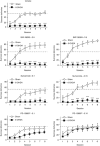Implication of dopamine D3 receptor activation in the reversion of Parkinson's disease-related motivational deficits
- PMID: 24937095
- PMCID: PMC4080324
- DOI: 10.1038/tp.2014.43
Implication of dopamine D3 receptor activation in the reversion of Parkinson's disease-related motivational deficits
Abstract
In addition to the classical motor symptoms, motivational and affective deficits are core impairments of Parkinson's disease (PD). We recently demonstrated, by lesional approaches in rats, that degeneration of the substantia nigra pars compacta (SNc) dopaminergic (DA) neurons is likely to have a crucial role in the development of these neuropsychiatry symptoms. We have also shown that, as in clinical investigations, chronic treatment with levodopa or the DA D2/D3 receptor (D2/D3R) agonist ropinirole specifically reverses these PD-related motivational deficits. The roles of specific DA receptor subtypes in such reversal effects remain, however, unknown. We therefore investigated here the precise involvement of D1, D2 and D3R in the reversal of the motivational and affective deficits related to SNc DA neuronal loss. Three weeks after bilateral and partial 6-hydroxydopamine (6-OHDA) SNc lesions, rats received 14 daily intraperitoneal administrations of the selective D1R agonist SKF-38393 (2.5 or 3.5 mg kg(-1)), the selective D2R agonist sumanirole (0.1 or 0.15 mg kg(-1)), or the preferring D3R gonist PD-128907 (0.1 or 0.15 mg kg(-1)). Anxiety-, depressive-like and motivated behaviors were assessed in an elevated-plus maze, a forced-swim test, and an operant sucrose self-administration procedure, respectively. All DA agonists attenuated anxiety- and depressive-like behaviors. However, only PD-128907 reversed the motivational deficits induced by 6-OHDA SNc lesions. This effect was blocked by a selective D3R (SB-277011A, 10 mg kg(-1)), but not D2R (L-741,626, 1.5 mg kg(-1)), antagonist. These data provide strong evidence for the role of D3R in motivational processes and identify this receptor as a potentially valuable target for the treatment of PD-related neuropsychiatric symptoms.
Figures





Similar articles
-
Implication of dorsostriatal D3 receptors in motivational processes: a potential target for neuropsychiatric symptoms in Parkinson's disease.Sci Rep. 2017 Jan 30;7:41589. doi: 10.1038/srep41589. Sci Rep. 2017. PMID: 28134302 Free PMC article.
-
Dopamine D1 receptor agonism induces dynamin related protein-1 inhibition to improve mitochondrial biogenesis and dopaminergic neurogenesis in rat model of Parkinson's disease.Behav Brain Res. 2020 Jan 27;378:112304. doi: 10.1016/j.bbr.2019.112304. Epub 2019 Oct 15. Behav Brain Res. 2020. PMID: 31626851
-
Pramipexole reverses Parkinson's disease-related motivational deficits in rats.Mov Disord. 2014 Jun;29(7):912-20. doi: 10.1002/mds.25837. Epub 2014 Feb 11. Mov Disord. 2014. PMID: 24515412
-
What can rodent models tell us about apathy and associated neuropsychiatric symptoms in Parkinson's disease?Transl Psychiatry. 2016 Mar 8;6(3):e753. doi: 10.1038/tp.2016.17. Transl Psychiatry. 2016. PMID: 26954980 Free PMC article. Review.
-
Dopamine D3 receptor: A neglected participant in Parkinson Disease pathogenesis and treatment?Ageing Res Rev. 2020 Jan;57:100994. doi: 10.1016/j.arr.2019.100994. Epub 2019 Nov 22. Ageing Res Rev. 2020. PMID: 31765822 Free PMC article. Review.
Cited by
-
HIV-Associated Apathy/Depression and Neurocognitive Impairments Reflect Persistent Dopamine Deficits.Cells. 2021 Aug 21;10(8):2158. doi: 10.3390/cells10082158. Cells. 2021. PMID: 34440928 Free PMC article. Review.
-
Treatment of Apathy in Parkinson's Disease and Implications for Underlying Pathophysiology.J Clin Med. 2024 Apr 11;13(8):2216. doi: 10.3390/jcm13082216. J Clin Med. 2024. PMID: 38673489 Free PMC article. Review.
-
Unilateral and Bilateral Subthalamic Deep Brain Stimulation Differently Favour Apathy in Parkinson's Disease.Eur J Neurosci. 2025 Feb;61(4):e70019. doi: 10.1111/ejn.70019. Eur J Neurosci. 2025. PMID: 39962903 Free PMC article.
-
Efficacy of adjunctive low-dose cariprazine in major depressive disorder: a randomized, double-blind, placebo-controlled trial.Int Clin Psychopharmacol. 2018 Nov;33(6):312-321. doi: 10.1097/YIC.0000000000000235. Int Clin Psychopharmacol. 2018. PMID: 30045066 Free PMC article. Clinical Trial.
-
Risk of Drug-induced Movement Disorders with Newer Antipsychotic Agents.Tremor Other Hyperkinet Mov (N Y). 2022 Jun 8;12:19. doi: 10.5334/tohm.695. eCollection 2022. Tremor Other Hyperkinet Mov (N Y). 2022. PMID: 35836971 Free PMC article. Review.
References
-
- Chaudhuri KR, Schapira AH. Non-motor symptoms of Parkinson's disease: dopaminergic pathophysiology and treatment. Lancet Neurol. 2009;8:464–474. - PubMed
-
- Leentjens AF, Dujardin K, Marsh L, Martinez-Martin P, Richard IH, Starkstein SE, et al. Apathy and anhedonia rating scales in Parkinson's disease: critique and recommendations. Mov Disord. 2008;23:2004–2014. - PubMed
-
- Marin RS, Biedrzycki RC, Firinciogullari S. Reliability and validity of the Apathy Evaluation Scale. Psychiatry Res. 1991;38:143–162. - PubMed
-
- Thobois S, Ardouin C, Lhommee E, Klinger H, Lagrange C, Xie J, et al. Non-motor dopamine withdrawal syndrome after surgery for Parkinson's disease: predictors and underlying mesolimbic denervation. Brain. 2010;133:1111–1127. - PubMed
Publication types
MeSH terms
Substances
LinkOut - more resources
Full Text Sources
Other Literature Sources
Medical
Miscellaneous

